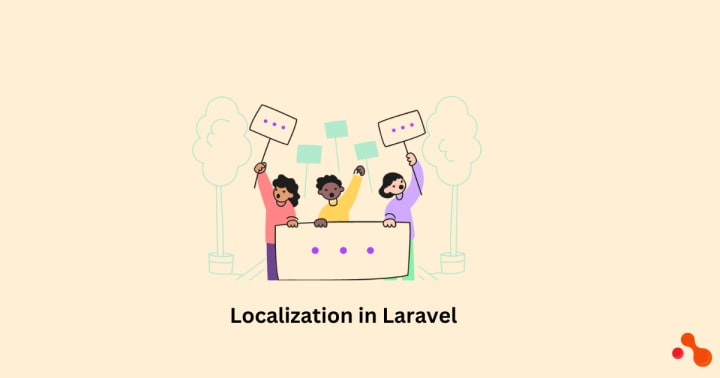How to Implement Multilingual Support in Laravel
Implement Multilingual Support in Laravel

Introduction
Multilingual support is crucial in web applications; businesses must recognize this need. Imagine you have a cool app that only works in one language. That means people who speak other languages won't be able to use it. Let's say you want to hire developers to make your app available in multiple languages. Doing so opens doors to a wider audience and potential customers worldwide. Plus, hiring remote developers can bring diverse perspectives and insights to the table, making your app even better. So, remember, embracing multilingual support can be a game-changer for your web app!
Localization in Laravel
Localization in Laravel web development refers to adapting a website or web application to suit different languages, regions, and cultures. It allows users from various parts of the world to interact with a website in their preferred language and with content that resonates with their cultural context. Laravel, a popular PHP framework for web development, provides built-in features that make localization easier and more efficient. Let's explore the definition and significance of localization in web development and delve into Laravel's localization capabilities.

Definition and Significance of Localization in Web Development:
1. Localization enables websites to cater to a diverse audience by providing content in their native language. For example, if a website is available in English and Spanish, users can choose their preferred language for a more personalized experience.
2. Localization goes beyond translating words; it also involves adapting date formats, currencies, units of measurement, and cultural nuances. This ensures that users feel comfortable and familiar with the content and user interface.
3. Localization enhances user engagement and satisfaction by creating a seamless experience. When users can understand and connect with a website's content, they are more likely to stay longer, explore further, and potentially convert into customers.
4. It expands business opportunities by tapping into new markets. Localizing a website allows businesses to reach a wider audience and increase their chances of attracting international customers.
Laravel's Built-in Localization Features:
1. Language Files: Laravel allows developers to store language strings in separate files, making it easy to manage translations. Each language has its file, containing an array of key-value pairs, where the keys represent the original language and the values are the translations.
2. Localization Helper Functions: Laravel provides helper functions, such as **trans()** and **__('')**, to retrieve translated strings in the desired language. Developers can simply wrap the translatable text within these functions, and Laravel will automatically fetch the appropriate translation based on the user's language preference.
3. Language Switching: Laravel facilitates easy language switching within a website. Developers can provide language options through drop-down menus or flags, allowing users to change their preferred language with a single click. Laravel handles the language switching and loads the corresponding translations accordingly.
4. Pluralization and Variables: Laravel's localization features support pluralization, allowing developers to dynamically handle singular and plural forms of words. Additionally, developers can pass variables to language strings, making it possible to personalize the translated content based on user-specific data.
By leveraging Laravel's built-in localization features, developers can streamline the process of adapting websites to different languages and cultures, creating a more inclusive and engaging user experience. Laravel development company and remote developers experienced in Laravel can utilize these features to deliver multilingual websites that cater to a global audience.
Configuring Laravel for Multilingual Support
To make your Laravel application multilingual, follow these steps:

1. Set the Default Language:
- Open the **`config/app.php`** file in your Laravel project.
- Find the **`'locale'`** key and set its value to the default language you want. For example, **`'en'`** for English.
- Save the file.
2. Add Language Files:
- Create a new directory called **`resources/lang`** in your Laravel project if it doesn't exist already.
- Inside the **`lang`** directory, create a subdirectory for each language you want to support. For example, **`en`** for English and **`es`** for Spanish.
- Inside each language subdirectory, create a PHP file with the same name as the subdirectory. For example, **`en.php`** and **`es.php`**.
- In each language file, define an associative array with key-value pairs representing the translations. For example:
```
phpCopy code
// en.php
return [
'welcome' => 'Welcome',
'home' => 'Home',
// Add more translations here
];
```
- Add translations for each supported language in their respective language files.
3. Translate Your Views:
- Open the views where you want to display translated text.
- Wrap the text you want to translate with the **`@lang`** directive and pass the translation key as an argument. For example:
```
htmlCopy code
<!-- Displaying a translated welcome message -->
<h1>@lang('welcome')</h1>
```
- Laravel will automatically load the translation based on the current language.
4. Change the Application Language:
- If you want to change the language dynamically, you can create language switching functionality.
- Add language switching options to your views, such as buttons or a dropdown menu, that trigger a request to change the language.
- In your controller or route, update the application's locale using the **`App`** facade. For example:
```
phpCopy code
// Switching to Spanish
App::setLocale('es');
```
- The application will now use the selected language for translations.
Remember to add translations for all the text you want to display in different languages. By following these steps, you can configure Laravel to support multilingual websites or applications easily.
Translating Text and Messages
Do you know that you can make your website speak different languages? Laravel, a popular web development framework, makes it super easy to translate text and messages. Let's explore how you can do it in a fun and understandable way, even if you're a 16-year-old kid!
1. Language Keys: Laravel uses language keys to represent different translations. Think of them as secret codes that unlock different languages. Here's how it works:
- You define language keys in a language file. For example, "welcome_message" could be a language key for a welcome message on your website.
- Each language file contains translations for different languages. So, for English, the translation for "welcome_message" could be "Welcome to our awesome website!"
- Laravel automatically detects the user's preferred language when your website loads and fetches the translation based on the language key.
1. Placeholders: Sometimes, translations need to include dynamic information, like a user's name. Laravel makes it possible with placeholders. Check this out:
- Let's say you have a greeting message that says, "Hello, {name}!" The "{name}" is a placeholder for the user's name.
- In your language file, you define the translation for the greeting message, including the placeholder, for example, "Hello, {name}!" (in Spanish, it could be "¡Hola, {name}!").
- When you display the greeting on your website, Laravel automatically replaces the placeholder with the user's name.
1. Example Usage:
- Suppose you have a button on your website that says "Read More." To make it translatable:
- Define a language key, such as "read_more_button."
- In your language file, provide translations for different languages, like "Read More" (English) and "Leer Más" (Spanish).
- When a user visits your website, Laravel displays the appropriate translation based on their language preference.
Using language keys and placeholders, Laravel empowers you to create multilingual websites effortlessly. So, whether running a Laravel development company or hiring remote developers, knowing how to translate text and messages in Laravel opens up a world of possibilities!
Handling URL Localization and Routes
URL localization refers to adapting website URLs to different languages or regions. It allows users to access content in their preferred language or location. In Laravel, a popular PHP framework for web development, handling URL localization can be challenging. However, Laravel provides useful features to tackle these challenges effectively. Let's explore how Laravel handles URL localization and routes.

Challenges of URL Localization:
1. Language-specific URLs: Websites often need to generate URLs specific to different languages. For example, a blog may have URLs like "/en/blog" for English and "/es/blog" for Spanish. Generating and managing these language-specific URLs can be complex.
2. Dynamic route parameters: URLs with dynamic parameters, such as "/products/{id}", must be localized while preserving the dynamic part. This presents a challenge in generating localized URLs.
3. Maintaining route consistency: When a user switches languages, it's essential to ensure the URLs remain consistent. For instance, if a user is on "/en/products" in English, switching to Spanish should redirect them to "/es/productos" instead of a different page.
How Laravel Handles URL Localization:
1. Route-based localization: Laravel allows defining routes specific to each language. For example, you can define an English route like this:
```
phpCopy code
Route::get('/en/blog', [BlogController::class, 'index']);
```
Similarly, a Spanish route can be defined as:
```
phpCopy code
Route::get('/es/blog', [BlogController::class, 'index']);
```
1. Generating localized URLs: Laravel provides a convenient way to generate localized URLs using the **`route()`** helper function. For example, to generate a URL for the English blog route, you can use:
```
phpCopy code
$url = route('blog', ['locale' => 'en']);
```
This will generate "/en/blog" as the URL.
1. URL parameters in localized routes: Laravel allows preserving dynamic route parameters when generating localized URLs. For example, to generate a URL for a product with ID 123 in English, you can use:
```
phpCopy code
$url = route('product', ['locale' => 'en', 'id' => 123]);
```
This will generate "/en/products/123" as the URL.
1. Route middleware: Laravel provides middleware that can handle route localization. This middleware can detect the user's preferred language from their browser settings or other sources and set the appropriate language for the route.
Conclusion
In conclusion, it is crucial to prioritize providing a seamless multilingual experience in today's globalized world. This means ensuring people can easily interact and access information in their preferred language, regardless of location. Businesses can effectively cater to a diverse audience and expand their reach by doing so. To achieve this, companies may need to hire developers with expertise in multilingual software development. These developers can design and implement user-friendly interfaces, translation features, and language-specific functionalities. Hiring remote developers can also provide access to a wider talent pool, enabling companies to tap into specialized skills and knowledge from different parts of the world.
About the Creator
Mukesh Ram
I founded Acquaint Softtech Private Limited with a vision to make quality developers affordable to everyone. With my blood, sweat, and tears I haven’t just been able to sustain but thrive over the years.
Enjoyed the story? Support the Creator.
Subscribe for free to receive all their stories in your feed. You could also pledge your support or give them a one-off tip, letting them know you appreciate their work.






Comments
Mukesh Ram is not accepting comments at the moment
Want to show your support? Send them a one-off tip.